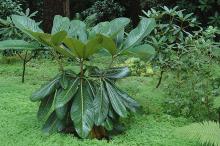Rhododendron sinogrande
Common name:
Sinogrande Rhododendron
Pronunciation:
rho-do-DEN-dron si-no-GRAN-dee
Family:
Ericaceae
Type:
Broadleaf
Native to (or naturalized in) Oregon:
No
- Broadleaf evergreen shrub or tree, up to 35 ft (10.5 m) high, young shoots silvery gray, stout and 2.5 cm thick. Leaves alternate, simple, oval or oblong, occasionally obovate, rounded at both ends, 25-75 cm long and 15-40 cm wide (considered the largest leaved of all rhododendrons), at first scruffy gray above, finally dark green and hairless, thin silvery to fawn indumentum below, prominent mid-rib below with 14-16 parallel veins pairs arising from it. Flowers about 3 inches wide, bell-shaped, dull creamy white to soft yellow, red patches at the base, from 20-30 flowers per clusters.
- 10°F, early, 4/4/3 [flower / plant & foliage / performance; scale 1 (poor) - 5 (best)].
- Native to China (Yunnan), SE Tibet, NE Burma and India (Arunachal Pradesh).
- George F. Forrest (1873-1932) discovered it 1921 growing at 11,000 ft (3,350 m) in western Yunnan, China, and later in Burma, Tibet and Assam. It grows in rhododendron forests, in mixed forests, in rhododendron and bamboo forests, on rocky slopes, and form extensive forests by itself, at elevations of 7,000-13,000 ft (2,135-3,965 m) (Davidson, 1989).
- sinogrande: sino, pertaining to China; grande big, showy.





